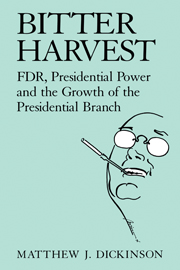Book contents
- Frontmatter
- Contents
- Preface and acknowledgments
- Introduction: The fruits of his labor? FDR and the growth of the presidential branch
- Part I Concepts and controversies
- Part II From cabinet to presidential government, 1933–9
- 2 Creating the resource gap: Bargaining costs and the First New Deal, 1933–5
- 3 The president needs help: The Brownlow Committee frames the Roosevelt response
- Part III Testing Roosevelt's staff system: The war years, 1939–45
- Part IV Lessons and considerations
- References
- Indexes
2 - Creating the resource gap: Bargaining costs and the First New Deal, 1933–5
Published online by Cambridge University Press: 21 January 2010
- Frontmatter
- Contents
- Preface and acknowledgments
- Introduction: The fruits of his labor? FDR and the growth of the presidential branch
- Part I Concepts and controversies
- Part II From cabinet to presidential government, 1933–9
- 2 Creating the resource gap: Bargaining costs and the First New Deal, 1933–5
- 3 The president needs help: The Brownlow Committee frames the Roosevelt response
- Part III Testing Roosevelt's staff system: The war years, 1939–45
- Part IV Lessons and considerations
- References
- Indexes
Summary
Roosevelt's First New Deal was, in essence, a single, gigantic preservation operation, designed to restore confidence in the free enterprise system at home and abroad. His primary objectives were to end the crippling deflation, lighten the debt carried by lower-income groups, put the unemployed to work, and offer structural relief to the nation's most important economic actors, particularly banks, railroads, insurance companies, real estate and mortgage firms, homeowners, and farmers.
In responding to the economic demands from these sectors FDR permanently broadened the scope, frequency, and importance of presidential bargaining, and thus its cost. This exposed a bargaining resource gap within the presidential advisory system. Essentially, Roosevelt had inherited a cabinet-centered advising system that was severely limited in its ability to collectively provide the resources required to accurately predict the likely consequences of his New Deal bargaining choices.
Because he primarily focused during the first term on resuscitating the nation's economy, however, FDR temporarily bridged this gap by utilizing a jerry-rigged administrative system. It was composed primarily of four staff components: an expanded cabinet and staff secretariat; institutional staff agencies, particularly the Bureau of the Budget; a corps of White House aides, supplemented by other government officials detailed to the White House; and an assortment of friends, politicos, and other advisers drawn from the public and private sectors.
Of these, the cabinet was historically the most important source of advice and the one FDR initially turned to most frequently.
- Type
- Chapter
- Information
- Bitter HarvestFDR, Presidential Power and the Growth of the Presidential Branch, pp. 45 - 85Publisher: Cambridge University PressPrint publication year: 1996



